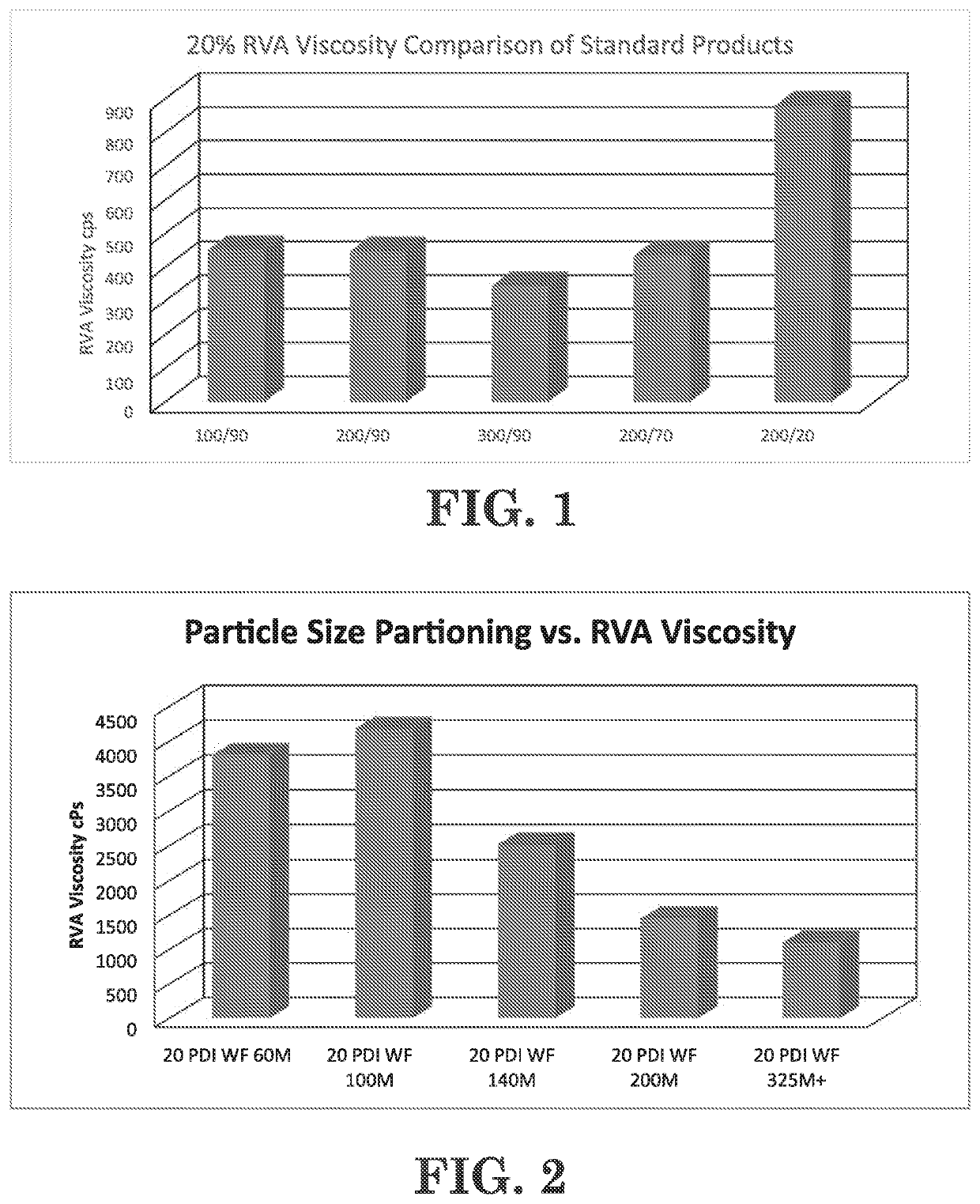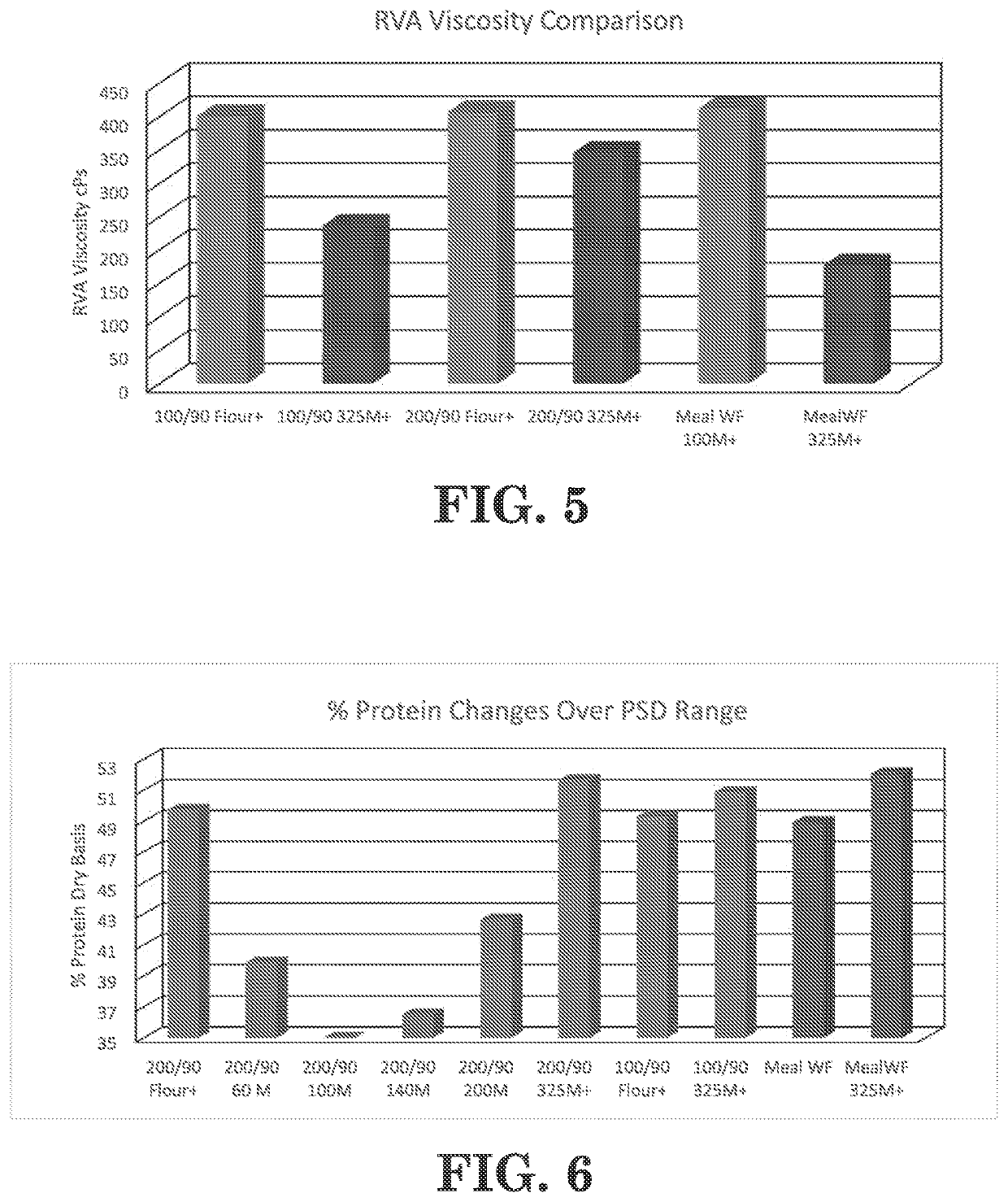Soy milling and fractionation
a technology of soy milling and fractionation, applied in the field of soy products, can solve the problems of poor water resistance, lack of durability, and typical adhesive compositions made from these materials
- Summary
- Abstract
- Description
- Claims
- Application Information
AI Technical Summary
Benefits of technology
Problems solved by technology
Method used
Image
Examples
example 1
y Grinding and Fractionating
[0075]Two types of precursor materials were used for comparison: unground soy flakes (which were coarsely ground in laboratory) and pre-ground soy flours (which were ground down to flours prior to usage in Example 1). Unground soy flake precursor materials included extracted and dried soy white flakes (WF) with protein dispersibility index (PDI) of 90 PDI soy white flake (“90 PDI WF”) and 20 PDI soy white flake (“20 PDI WF”), in addition to a soy Extracted Meal flake (“Meal WF”) taken from the meal feed line, before milling, and before removal of hexane and air dried. (Cargill®, Cedar Rapids, Iowa). Additionally, a 50 PDI soy white flake (“50 PDI WF”) that was not yet milled was used. (ADM facility, Amsterdam). These samples were not yet ground or milled when obtained.
[0076]Pre-ground soy flour precursor materials (i.e., soy flours) included standard products of 100 mesh and 200 mesh, with PDI values of 90, 70, and 20 (e.g., “100 / 90,”“100 / 70,”“100 / 20,”“20...
example 2
of Example 1
[0082]The resulting soy products that began as an unground soy flake precursor material (20 PDI WF, 90 PDI WF, Meal WF, and 50 PDI WF samples) produced about 40 wt. % to about 50 wt. % total soy product compared to the precursor material. In contrast, the soy product that began as pre-ground soy flour precursor materials (100 / 90, 100 / 70, 100 / 20, 200 / 90, 200 / 20, 300 / 90 samples) produced about 70 wt. % to about 84 wt. % compared to the precursor soy flour.
[0083]However, the soy product that began as pre-milled soy flour precursor materials did not produce as great of a protein amount compared to the soy product that began as unground soy flake precursor materials and was coarsely ground in the laboratory. It is theorized that the finely ground soy flour precursor material also contained finely ground fiber and hemi-cellulosic material that are considered impurities. In general, a higher protein level in soy flour allows for stronger adhesive properties.
[0084]The resulting ...
example 3
ng Trial
[0102]Milled and fractionated soy products were also produced with jet milling and air classification technology. Examples 3 and 4 used a PDI 90 white flake (“90 PDI WF”) precursor material (Cargill, Cedar Rapids, Iowa).
[0103]Example 3 included the use of varying speeds to grind the soy flake material, and analysis of protein content and viscosity. The results of Example 3 analyzed milling and fractionating of 90 PDI white soy flakes (“90 PDI WF”). The 90PDI WF was defatted (i.e., hexane was extracted) but had not been previously milled. In Example 3, the 90PDI WF was coarsely milled and fractionated to reduce the amount of non-proteinaceous components.
[0104]For Example 3, 90 PDI WF was used. (Cargill®, Cedar Rapids, Iowa). Equipment used for Example 3 included a Model DPM-2 Fluidized Bed Jet Mill for jet milling, and a Model 250 High Efficiency Centrifugal Air Classifier for air classification (Aveka CCE Technologies, Cottage Grove, Minn.).
[0105]Particle size was analyzed w...
PUM
| Property | Measurement | Unit |
|---|---|---|
| wt. % | aaaaa | aaaaa |
| wt. % | aaaaa | aaaaa |
| particle size | aaaaa | aaaaa |
Abstract
Description
Claims
Application Information
 Login to View More
Login to View More - R&D
- Intellectual Property
- Life Sciences
- Materials
- Tech Scout
- Unparalleled Data Quality
- Higher Quality Content
- 60% Fewer Hallucinations
Browse by: Latest US Patents, China's latest patents, Technical Efficacy Thesaurus, Application Domain, Technology Topic, Popular Technical Reports.
© 2025 PatSnap. All rights reserved.Legal|Privacy policy|Modern Slavery Act Transparency Statement|Sitemap|About US| Contact US: help@patsnap.com



